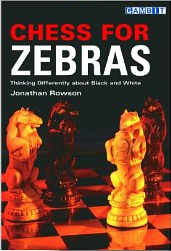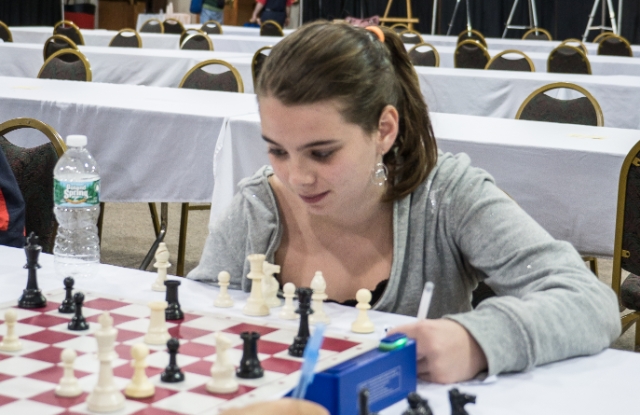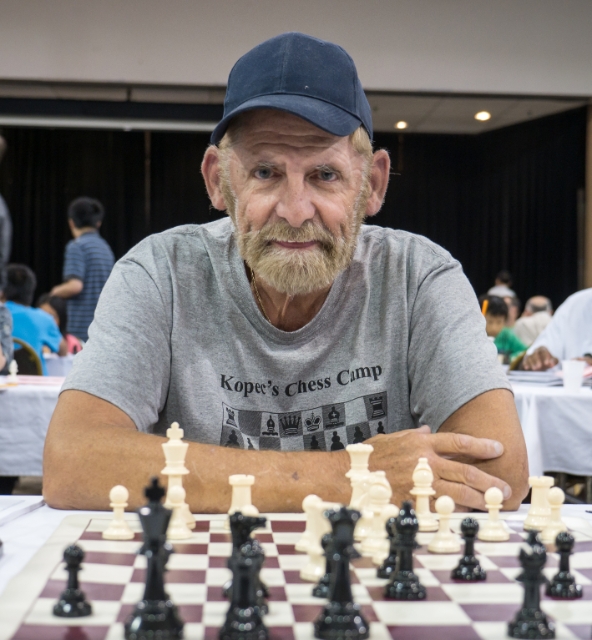I played in the Continental Open this year, 8 Aug - 10 Aug 2014 in Sturbridge MA. Great turnout, fun games, and I even got Carissa Yip's autograph on my rollup board :-)
This blog is an overall summary. I will post a few additional blogs with deeper analysis and thoughts on each of the games in the coming days.
Crosstable
My attitude going in was reasonable considering recent life events, and I simply wanted to play chess. So often I arrive at a tournament carrying tons of books with the intent on combining play and intense analysis and study afterwards. Trying to do both leads to #FAIL for both. Not this time. I left all books at home. I brought my phone (had to be turned off in the playing hall) and left my tablet and laptop and all books at home. I simply wanted to focus on the experience of playing, not wallowing in regret over past games or lost in anticipation of the next game. Just play chess... just play the game in front of you... that is it. Error check my game score and capture the moves on the phone right after the game, but no "check what the engine says" business for me.
Lately I have reading the "Chess For Zebras" book by Rowson which emphasizes attitude as a key ingredient. Dan Heisman also emphasizes attitude, and combines that with clock management, and they are very related.
Dan Heisman has a group on Chess.com called the Dan Heisman Learning Center. The group is dedicated to learning, and simulate OTB experience with long time controls in live games.
I went to the Continental Open tournament with the president of our local club, which saved on hotel room cost, and we had nice "chess philosophy" discussions at night to cap off a long day of games. The tournament is 6 rounds and we played the 3 day schedule, 2 long games per day, starting on Friday morning.
Performance Summary
I played in the U1500 section. On round 4 my opponent forfeited. On round 6 I needed to withdraw to prepare for an early flight the next day. I played 4 games, and lost 5 USCF ELO rating points (1434-->1429). I came in 9th out of 28:
- Round 1, Black side of a Bogo, win
- Round 2, White side of a Caro Kann, lose
- Round 3, Black side of a Sicilian, win
- Round 5, White side of a Colle, lose
I will post each game below with raw PGN, and notes in text regarding what I was thinking, but no deep analysis. I will post each game in subsequent blogs with deeper analysis.
Round 1
First round of the tournament. About 4 months since the last OTB tournament (G/60 one day), and 6 months since the last weekend tournament (Foxwoods, 4 day). I was paired Black with a scholastic player Depei, and felt strangely calm. I wasn't anxious about whether the student had opening tricks up their sleeve, or a tactical genius. I figured we are both in U1500, so let's just play chess and see what happens.
[Event "Continental Open"]
[Site "Sturbridge MA"]
[Date "2014.08.08"]
[Round "1"]
[White "Li, Depei"]
[Black "Reed, Harvey"]
[Result "0-1"]
[ECO "E11"]
[Plycount "114"]
[Eventdate "2014.08.08"]
[Eventtype "swiss"]
[Eventrounds "6"]
1.d4 Nf6 2.c4 e6 3.Nf3 Bb4+ 4.Bd2 Qe7 5.Bxb4 Qxb4+ 6.Qd2 Qxd2+ 7.Nbxd2 O-O 8.e3 Nc6 9.Bd3 d6 10.O-O Re8 11.Be2 e5 12.d5 Ne7 13.e4 Ng6 14.Rac1 Nf4 15.Rfe1 b6 16.b4 a5 17.b5 Nd7 18.Bd1 Nd3 19.Be2 Nxc1 20.Rxc1 Nc5 21.Rc3 h6 22.Nf1 Nxe4 23.Re3 Nc5 24.Ng3 f5 25.Nh5 f4 26.Nxf4 Bf5 27.Nh5 Rf8 28.Nh4 Bh7 29.Rg3 Rf7 30.Bg4 Ne4 31.Re3 Kh8 32.Rh3 Nxf2 33.Rg3 Nxg4 34.Rxg4 Raf8 35.h3 g5 36.Nf3 Bf5 37.Rg3 Bg6 38.Nxg5 Rf1+ 39.Kh2 hxg5 40.Rxg5 Bxh5 41.Rxh5+ Kg7 42.Rh4 R1f4 43.Rh5 R8f5 44.Rxf5 Rxf5 45.g4 Rf2+ 46.Kg3 Rxa2 47.h4 Ra3+ 48.Kh2 e4 49.Kg2 Rf3 50.g5 a4 51.g6 a3 52.h5 a2 53.h6+ Kxg6 54.h7 Kxh7 55.c5 a1=Q 56.Kh2 Qf1 57.c6 Rh3#
0-1
The game opens as a Bogo. I'll get into opening analysis in a subsequent blog, but the summary is that I played a practice Bogo with the local club president just the day before (day of prep before tournament) and felt confident, but managed to keep my confidence in check. Spoiler alert, round 2 (see below) I did not keep my confidence in check.
The major feature of this first round is that I concentrated on maintaining tension, and minimizing counterplay. My opponent's decisions helped of course and I was happy to go along. By maintaining tension, and minimizing counterplay, eventually my opponent can't keep track of all the related tactics, and on White's 18th move drops the exchange and on White's 22nd move drops a pawn. However, one mistake deserves another, and I was next. I confused a move order and allowed a tactic on Black's 25th move, and White takes back a pawn, and gets in a lot of counterplay. The counterplay/attack on White's part goes strong until Black's 35th move when Black starts to uncoordinate White's pieces, resulting in material loss for White, and eventually White loses the game to checkmate on move 57. My opponent finished 24 out of 28.
Round 2
I start round 2 (over) confident and playing another scholastic player, Elizabeth. Elizabeth finished 4th out of 28, and deserves it. She was poised, thoughtful, checked every move, and was very generous in going over the game after she ripped my head off in the game, lol. She also beat my round 5 opponent, after he re-entered the tournament, knocking him just one place out of prize money. Ouch.
[Event "Continental Open"]
[Site "Sturbridge MA"]
[Date "2014.08.08"]
[Round "2"]
[White "Reed, Harvey"]
[Black "Moshkevich, Elizabeth"]
[Result "0-1"]
[ECO "B18"]
[Plycount "70"]
[Eventdate "2014.08.08"]
[Eventtype "swiss"]
[Eventrounds "6"]
1.e4 c6 2.d4 d5 3.Nc3 dxe4 4.Nxe4 Bf5 5.Ng3 Bg6 6.Nf3 Nf6 7.Bd3 Nbd7 8.O-O e6 9.Bg5 Qc7 10.Bxg6 hxg6 11.Qd2 Bd6 12.c4 Ne4 13.Nxe4 Bxh2+ 14.Kh1 Bf4+ 15.Kg1 Bxd2 16.Bxd2 O-O-O 17.g3 Rh5 18.Bf4 e5 19.dxe5 Nf8 20.e6 Qe7 21.Rfe1 Nxe6 22.Be3 Kb8 23.a4 f5 24.Ned2 Qf8 25.Bxa7+ Kxa7 26.Rxe6 Qh8 27.Kg2 g5 28.Nf1 g4 29.Nh4 Qh7 30.Ne3 g5 31.Nexf5 gxh4 32.Nxh4 Qf7 33.Rae1 Rd2 34.b3 Qxf2+ 35.Kh1 Qh2#
0-1
I am White, played my usual 1.e4 and Black responded with 1...c6. In my mind I am thinking "great!" because I have played Caro Kann before, but... several years ago, as Black not White, and worse, during an era where I kept trying different variations of Caro Kann, never settling on any variation. In short, I was dabbling.
But here I am several years later, as White thinking "I know what to do" (not), and started banging out moves (danger), and not thinking deeply about what is going on. Who owns what squares and that sort of thing... I was pretty sure I was in book through 7.Bd3 and after 7...Nbd7 (not capturing my d3 Bishop) I was thinking "at some point White is supposed to capture, but when? and what provokes it?" Clearly I should have kept that thought in my head as White kept playing moves other than capturing Black's Bishop. Unfortunately the alarm bells of danger were ringing deep under an ocean of hubris, and on move 10, White captures the Bishop instead of the other way around. Even then, White could probably recover if only he were alert to danger, but sadly that is not the case. By Black's 11th move, she already has a substantial Queen/Bishop battery pointing at my h2 square, and only now am I starting to sit up and pay attention.
At this exact moment, I am thinking I need to put my Rook on e1 in order to prevent ...Ne4. I thought I worked through all the variations, and calculated that I could meet ...Ne4 with Nxe4. My calculations were very wrong because I didn't factor in the Black Rook on h8, and after a nifty ...Bxh2, there is a discovered attack on my Queen with the Black Bishop. That is the move I did not see. In short I willfully allowed a massive attack, and did not calculate all the variations.
Result: I exchange my Queen for a Bishop, and her attack intensifies dramtically... I will post analysis in a subsequent blog.
Here is my opponent (see photo credit below) after White's 32nd move, with her Queen and Rook lined up on the h-file, and she can literally "see" the checkmate she will deliver in just a few moves.
This round reminds me that chess is a brutal game!
Round 3
I start round 3 very humbled by the last game. I play the stronger brother of my round 1 opponent. Third scholastic opponent in a row. I have Black, and this time we are playing SIcilian. I am a little (but not much) more familiar with Sicilian than Bogo, however keenly aware not to be over confident as I was in round 2.
[Event "Continental Open"]
[Site "Sturbridge MA"]
[Date "2014.08.09"]
[Round "3"]
[White "Li, Deyuan"]
[Black "Reed, Harvey"]
[Result "0-1"]
[ECO "B88"]
[Plycount "68"]
[Eventdate "2014.08.08"]
[Eventtype "swiss"]
[Eventrounds "6"]
1.e4 c5 2.Nf3 d6 3.d4 cxd4 4.Nxd4 Nf6 5.Nc3 Nc6 6.Bc4 e6 7.O-O Be7 8.Be3 O-O 9.Qe2 a6 10.Rad1 Qc7 11.Bb3 Nxd4 12.Rxd4 b5 13.Qf3 e5 14.Rd2 Bb7 15.Bg5 Nxe4 16.Nxe4 Bxg5 17.Re2 Kh8 18.Qh5 Bh6 19.c3 f5 20.Ng5 Qc6 21.f3 Bxg5 22.Qxg5 f4 23.Qh4 Rf6 24.Bc2 Rh6 25.Qe7 Re8 26.Qf7 Bc8 27.Be4 Qb6+ 28.Kh1 Qd8 29.Rd1 Rf8 30.Qd5 Qh4 31.h3 Bxh3 32.gxh3 Qxh3+ 33.Kg1 Qh1+ 34.Kf2 Rh2#
0-1
The game progresses along familiar lines and ideas. After Whites 11th move, I see an opportunity to disrupt coordination of my opponent with an "anti-positional" move, but with a pawn formation that is common in Najdorf (Black pawns on e5 and d6, d6 being "backward"). I lure the White Rook to e4 with a Knight capture 11...Nxe4, then develop my light Bishop with 12...b5, kick the White Rook with 13...e5 and then not give White time to attack the backward pawn on e5.
This gives Black time to develop and equalize, and by 19...f5 White's Rooks are mostly out of play, the White Knight is getting kicked, revealing a Black Queen/Bishop battery on g2, and the excitement starts. The White Queen finds herself alone on the Kingside, with Black's Rooks starting to lift and attack on the Kingside as well. There is only so much room on the Kingside, and the Queen eventually has to leave. Instead of retreating the White Queen, White double downs and uses his Queen as a lone attacker deep in Black's well defended territory.
With 29...Rf8 White's Queen has to leave and Black's Queen joins Black's Rook in a Kingside attack, also aided by Black's Bishop, where there are no White defenders, save his pawn cover, which is easily shattered. Checkmate.
Round 4
My opponent forfeits! Bummer, after waiting for an hour I can play some practice games...
Round 5
I start this penultimate round in the morning, fairly decent rest and breakfast, and ready to duke it out in a great chess game. I have a good attitude, but as we all know, we need to combine good attitude with skill and knowledge... and determination! As we were chit-chatting before the game, he told me he re-entered and was determined to get in the prize money!
[Event "Continental Open"]
[Site "Sturbridge MA"]
[Date "2014.08.10"]
[Round "5"]
[White "Jacques, Louis"]
[Black "Reed, Harvey"]
[Result "1-0"]
[ECO "D05"]
[Plycount "43"]
[Eventdate "2014.08.08"]
[Eventtype "swiss"]
[Eventrounds "6"]
1.d4 Nf6 2.e3 e6 3.Bd3 d5 4.Nd2 Bd6 5.Ngf3 O-O 6.O-O b6 7.Ne5 c5 8.c3 Qe8 9.f4 Ba6 10.Qe2 Bxd3 11.Qxd3 c4 12.Qc2 Nc6 13.Rf3 Ne7 14.e4 b5 15.Rh3 Nxe4 16.Nxe4 dxe4 17.Qxe4 f5 18.Qf3 Bxe5 19.fxe5 Qg6 20.Bf4 Qg4 21.Qb7 Nd5 22.Rg3
1-0
Here is my opponent. Very friendly, very determined to win, which he did, lol! White opens 1.d4, and I'm thinking "hmm, maybe another Bogo?" Sadly he follows my 1...Nf6 with 2.e3. Then I am stumped. Bummer. But not to worry I play as though we simply went out of book early, but that was denial on my part because he actually had a plan, I didn't and afterwards he said my defense was ok, and typical but not sufficient. Again I will post an analysis in a subsequent blog.
Through White's move 6.O-O we are almost but not quite symmetrical. My plan was to maintain tension in the center for a while, and also exchange of White's light Bishop to prevent any Bxh7 sacs, thinking the White Queen would go to c2 and form a battery. With 11.Qxd3 the Bishops are exchanged. Then for some reason (will be discussed later in my analysis blog), I release tension. In hindsight, I think that is not a good decision, since it gives White a clear path for a Kingside attack, which is exactly what happened.
By move 19 Black is confused, trying to exchange Queens, allowing severe counterplay by White's Queen swinging around Black's back rank. However Black's danger alarms were severely damaged and Black didn't see that the White Queen on the back rank and White Rook on the g-file cooperate to deliver a fatal attack. Done.
Ironically my opponent in this round, was stopped by my round 2 opponent from getting into the money position... by just one place... Such is the game of chess!
Round 6
For this round I withdrew because I had an early flight the next morning. I thoroughly enjoyed the tournament, and special thanks to Mark Kaprielian for the photos, and lots of chess kibitzing 
Photo Credits:
Mark Kaprielian, President MetroWest Chess Club









